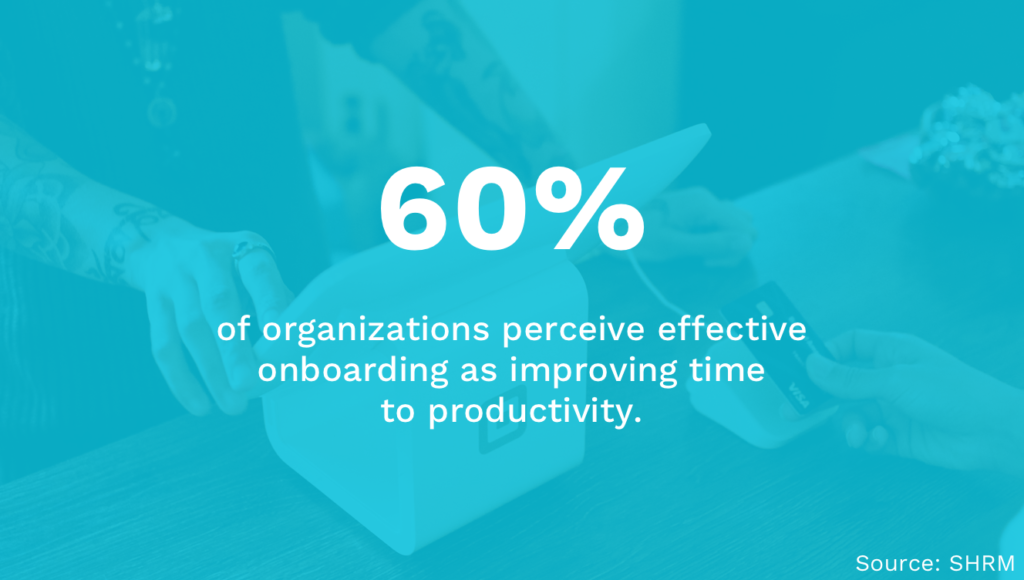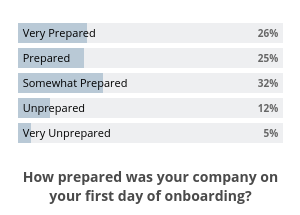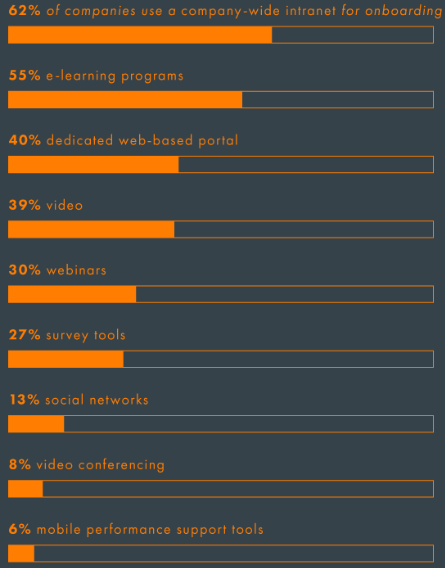From higher retention to improved new-hire productivity, a good onboarding program has many benefits for retail companies, especially because these businesses report some of the highest employee turnover rates across all industries.
Yet, a lot of retail businesses fail to develop a structured onboarding process. This lack of proper retail onboarding puts the retail workforce — that’s made up of myriad part-timers, seasonal employees and those who take up retail jobs only until they can find “real jobs” — at an even higher risk of attrition as many of them immediately start looking for other opportunities (and there are plenty available!).
That’s why it’s extremely important to not just attract and hire the right retail talents, but also offer them a great retail onboarding experience that inspires them to stay with you. Effective retail onboarding results in:
- Decreased turnover. Did you know that employees who go through a well-structured onboarding program are 69% more likely to stay at the company for up to 3 years?
- Higher performance. A well-thought-out onboarding program includes a lot of training, and therefore it primes the new employees for success. Whether it’s understanding the standard of service to strive for or simply knowing the right job accountabilities and spending time on those and not “busywork”, new employees get a lot out of an onboarding program. These naturally translate to better performance right from the onset.
- Higher revenue. A whopping 92% of managers agree that reducing turnover rates by one retail staff per month would also spur profits. Which means the more new hires you retain, the better your profits can get. Not just that, low attrition also naturally translates to lower hiring costs.
With that, let’s now see some steps you can follow to create a great retail onboarding program for your new hires.
What’s in?
- Set onboarding goals.
- Nail day ONE.
- Plan for the first 120 days. At least.
- Do organizational, technical, and social onboarding.
- Build a lean onboarding tech stack.
- Keep seasonality in mind.
- Create a thorough onboarding plan.
Here goes!
Like what you see?
Don’t miss out. Subscribe to our quarterly digest to get the latest TA and TM resources delivered right to your inbox.
1. Set onboarding goals.
Retail onboarding — or even onboarding, in general — is a journey. And just like any other journey, onboarding needs a few clear goals to ensure that the new hires move in the right direction and at a pace that will help them thrive in your fast-moving retail ecosystem.
Here are a few sample retail onboarding goals (to set when your new hires are about 4 weeks into the job):
- Scoring X% in an assessment on the different organizational aspects of your retail business, for example, understanding your processes, infrastructure, and policies.
- Showing X% proficiency in using the different tools your retail staff needs on a daily basis.
- Connecting X number of times with direct managers or seniors or peers.
Although the retail onboarding journey is a long and winding one, setting such early wins or goals can ensure that your new hires start right.
Furthermore, 53% of companies associate effective onboarding with improved customer satisfaction. That’s why you should not only design an onboarding process, but make it a priority.
2. Nail day ONE.
First day, first impression. Day one of your new hire onboarding is one of the most critical points in your new hire’s journey, and a lot depends on it.
The following chart shows the first-day preparedness at Walmart. As you can see, about 50% of the new hires feel the company isn’t fully prepared when they join.
Which means that there’s a good chance that a lot of your retail employees, too, also can feel somewhat unprepared.
Such hires could benefit immensely from a welcoming and reassuring first day at your store or outlet. Treating them to some sort of a welcome kit on their first day could come in handy here. Your retail onboarding kit could have goodies like a name tag, a company T-shirt, a notepad or some other useful item. Or it could also be a virtual kit with a company video together with the first-day agenda, basic paperwork, and guidelines.
3. Plan for the first 120 days. At least.
There’s not a lot of research around onboarding hourly employees (which make a big percentage of a typical retail workforce), but this one study from SHRM has found that new hourly employees report being fully onboard in about a period of three-and-a-half weeks. Their supervisors, however, report that they take about three months to get “fully functional”.
The same study has found that the onboarding content for most hourly workers is restricted to mostly paperwork with limited other onboarding practices such as job shadowing, assigning of mentors and introductions with the go-to people for seeking specific information.
Onboarding for most retail employees ends at the lowest level: compliance. This mostly includes just working on the needed paperwork. To improve your onboarding process, bear these four Cs in mind.
Now if this is the state of onboarding for your retail employees, then you can understand if they feel a sense of disconnect when working for you. This, in turn, somewhat explains why about 50% of all hourly workers leave their jobs within the first 120 days of joining.
Understand that while onboarding is an ongoing process — and not a one-day event as most retail businesses assume it to be — its first 120 days are the most critical. So think about all the things you can do during this period to equip your retail workers to feel welcome, productive, and happy during their first few months with you. If it helps, create a 30/60/90/120 day plan where each period introduces the new employees to a new level of onboarding.
4. Do organizational, technical, and social onboarding.
You can easily split your retail onboarding process into three parts:
- Organizational retail onboarding
- Technical retail onboarding
- And social retail onboarding
Let’s see what all goes under each.
Organizational onboarding is the part of retail onboarding where you help your new retail hires adapt to how you work — or how things work at your retail company.
Organizational onboarding includes many things right from the initial logistics of helping the candidates collect their ID cards to educating them on how they can go on with their day-to-day work, how the bonus and promotion structure works, how they can avail their health and other benefits, what kind of a career path they could chart with you, how they can do “overtime hours”, and more. Training about your different policies and practices around communications, shift scheduling and more also fall under organizational onboarding.
You should also use organizational onboarding to offer job clarity and include a quick assessment to see how well your new retail hires understand their job expectations and accountabilities.
L’Oréal has developed an onboarding app called Fit Culture App that helps the new hires navigate the company culture in an interactive and entertaining way.
Technical onboarding is the next important phase of your retail onboarding where you skill up your new hires on the work tools they’ll be using daily. For example, the POS terminal they’ll use to collect card payments or the barcode reader they’ll use to do the logistics. Technical onboarding also includes coaching — for example, sessions on how to bill efficiently, making more sales, offering a better customer service experience, and so on. Technical onboarding varies greatly based on the roles of the hires.
Lastly, social onboarding is the part of retail onboarding where you encourage your new employees to engage with about seven to ten of their colleagues so that they can connect on a more one-to-one basis and not feel isolated in their new jobs. You could pair up a new hire with a “buddy” and help build a sense of trust and friendship. Assigning a mentor to a new hire could also help here. Onboarding often fails if a company isn’t able to establish good working relationships — so don’t forget this part of your retail onboarding mix.
The state of retail recruitment
It is becoming increasingly difficult to hire – let alone retain – retail workers. Technological advancements have created an opportunity to overcome the biggest challenges in retail recruitment.
5. Build a lean onboarding tech stack.
As you can imagine, retail onboarding includes a lot of communication, many paperwork formalities, lots of feedback loops, multiple coaching sessions, interviews/interactions, tens of assessments, and a lot of back and forth during all of this.
So to keep track of your onboarding and to standardize its processes, build an onboarding tech stack with all the tools you’ll need.
Here’s a snapshot of some of the technologies that companies use in their onboarding process. You could use some of them to provide your new retail hires some world-class onboarding:
6. Keep seasonality in mind.
When it comes to planning onboarding programs for retail businesses, you have to consider seasonality as well, because seasonal hiring is an annual event for most retail businesses.
But having to make multiple new hires (maybe across multiple stores) and that too pretty quickly shouldn’t mean that your seasonal hires don’t get the onboarding they deserve. Just like your regular employees, your seasonal employees, too, need onboarding to do their best job serving your peak season rush. Also, they must feel good about working with you.
To ensure that your seasonal hires also get a reasonably paced onboarding, start their onboarding before the rush begins. If your onboarding is effective — and ensures that your seasonal employees feel equipped and like being part of the team (and not just like some additional help) — they’ll be happy to reconsider working for you when you need their services in the future, because, don’t forget they’ve many other competing seasonal work opportunities as well.
7. Create a detailed onboarding plan.
Now that you know all the steps that go into creating a winning retail onboarding program, pick each step from above and adapt it to create your custom onboarding plan for your retail hires.
Choose the tools you’ll need, define a timeline that works for your store’s (or your retail chain’s) unique working environment, the different assessments that can show a new hire’s success with respect to onboarding organizationally, technically, and socially, and so on.
Also, remember that an onboarding program isn’t a one time program. It can be improved. But to improve it, you need to measure your onboarding metrics. So when you start your retail onboarding program, make sure that you measure its effectiveness. You could do so by monitoring your turnover rates and recording them in your recruiting dashboard and also by collecting feedback from your new hires who quit too soon. And by studying the trends over time.
And strive to offer proactive onboarding. Proactive onboarding is one where the onboarding is strategically organized using a human resource management approach. Simply put, it’s one that helps the new hires succeed early on and focuses on retention — and doesn’t feel like following a checklist of mundane, disjoint activities that the new hires have to drag their way through.
…but it doesn’t have to be the case at your organization, if you take a proactive approach to onboarding your retail employees.
Wrapping it up
If you stop at hiring the right retail employees for your store(s), then you aren’t doing enough. You’re actually missing out on a hiring competitive advantage you can get over all the local businesses competing for the same retail talent as you are.
A good retail onboarding strategy can really set you apart. Of course, it’ll take you resources to develop one, but a good retail orientation program can make all the difference in employees who quit within months or those who stay and reskill/upskill to someday fill even the higher positions that come up across your retail business.
Whether it’s realizing short-term benefits (such as getting higher productivity right from the start and improved quality of work) or securing long-term gains (such as internal recruitments for newer positions as your business grows or reduced hiring costs as a result of lower turnout), retail onboarding can help improve your retail business’s bottom line. So if you don’t have a retail onboarding program, build one now. The above steps should offer you a good starting point!
The state of retail recruitment
It is becoming increasingly difficult to hire – let alone retain – retail workers. Technological advancements have created an opportunity to overcome the biggest challenges in retail recruitment.








